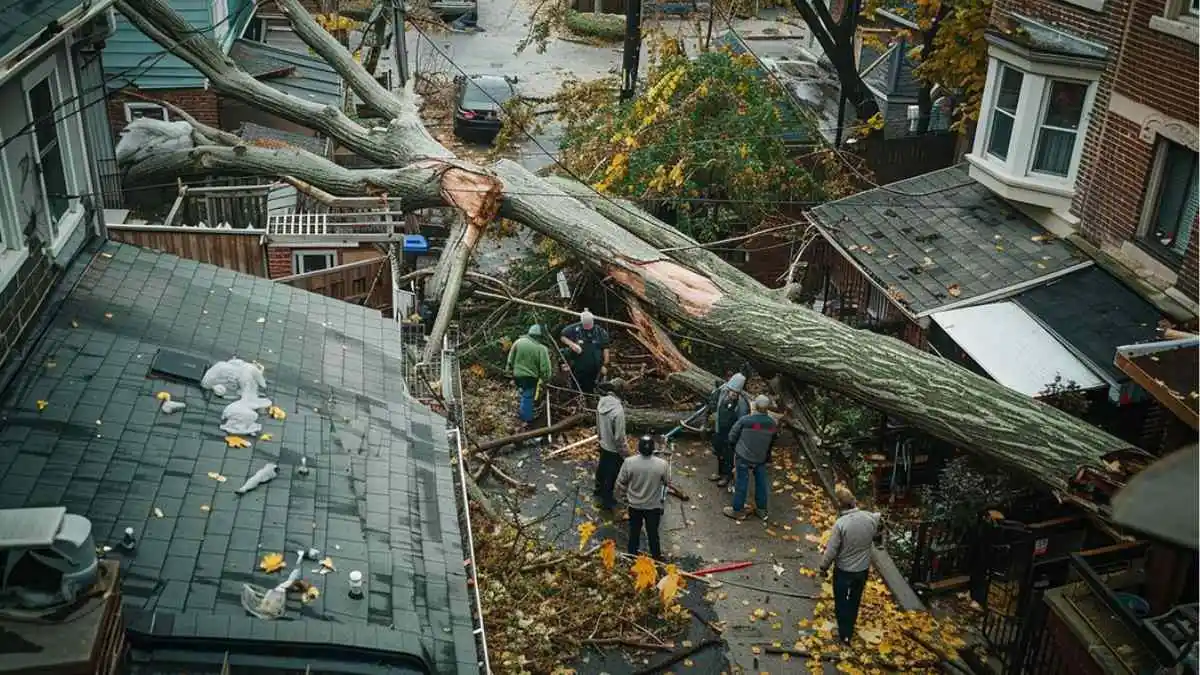HOME IMPROVEMENT
How Storm Restoration Helps Extend the Life of Your Roof

Roof damage from storms can be a common issue for homeowners, particularly in regions prone to extreme weather. High winds, heavy rain, hail, and falling debris can take a toll on your roof, leading to leaks, structural damage, and costly repairs if not addressed promptly. The good news is that storm restoration services can play a crucial role in restoring your roof to its former condition and, in many cases, even extending its lifespan. By acting quickly after a storm and ensuring that your roof receives the necessary care, you can prevent long-term damage and keep your home protected.
In this article, we’ll explore the ways in which storm restoration can help prolong the life of your roof, how to recognize storm-related damage, and why professional repair is essential for maintaining a strong and resilient roof.
Table of Contents
1. Identifying Storm Damage Early
The first step in extending the life of your roof through storm restoration is recognizing the signs of damage as soon as possible. After a severe storm, it’s essential to inspect your roof for any visible issues that could lead to larger problems down the road. Addressing these issues promptly ensures that your roof remains structurally sound and prevents further damage.
Signs of Storm Damage to Watch For:
- Missing or Damaged Shingles: High winds can cause shingles to become loose, curl, or blow off entirely. Missing shingles expose the underlying roof structure to moisture, which can lead to leaks and rot if not repaired quickly.
- Granule Loss: After a hailstorm, check your gutters and downspouts for granules from your shingles. Excessive granule loss can indicate that your shingles have been damaged, reducing their effectiveness in protecting your roof.
- Cracked or Dented Flashing: Flashing around chimneys, vents, and skylights is vulnerable to storm damage. If flashing is cracked, dented, or dislodged, water can easily seep into your home.
- Leaky Roof: Water stains on your ceilings or walls after a storm indicate that water has penetrated the roof. Even small leaks can lead to significant damage over time if left unaddressed.
By conducting a thorough inspection of your roof after every storm, you can spot issues early and take the necessary steps to restore your roof before the damage worsens.
2. Preventing Water Damage and Leaks
One of the most common issues resulting from storm damage is water intrusion. When shingles, flashing, or other components of your roof are damaged, water can seep into your home, causing leaks, mold growth, and structural problems. Storm restoration is essential for sealing up any vulnerabilities and preventing water from causing long-term damage to your roof and the interior of your home.
How Storm Restoration Helps with Water Damage:
- Repairing Leaks: A professional storm restoration team can identify and repair any leaks in your roof, ensuring that water cannot penetrate your home. Addressing leaks promptly is key to preventing further damage, such as rotting wood, mold, and water stains.
- Replacing Damaged Shingles: Shingles act as the first line of defense against water. If they are missing or damaged, water can easily find its way into your home. Storm restoration involves replacing these shingles to restore your roof’s protective barrier.
- Securing Flashing and Seals: Loose or damaged flashing around vents, chimneys, and skylights can be a major source of water intrusion. Storm restoration professionals will ensure that all flashing and seals are secure and watertight, preventing leaks in vulnerable areas.
By addressing water damage quickly through storm restoration, you can avoid costly repairs and keep your roof in good condition for years to come.
3. Restoring Roof Strength and Integrity
Storm damage weakens the structural integrity of your roof, making it more susceptible to future damage from even minor weather events. By restoring your roof after a storm, you reinforce its strength and ensure that it can continue to protect your home from the elements.
How Storm Restoration Reinforces Roof Integrity:
- Reinforcing Weakened Areas: If a storm has caused sections of your roof to weaken, such as damaged underlayment or support structures, storm restoration will repair and reinforce these areas. This ensures that your roof can withstand future storms without collapsing or failing.
- Replacing Broken Materials: Strong winds, hail, and falling debris can crack or break roofing materials, leaving your roof vulnerable to damage. Replacing these materials during storm restoration helps maintain the overall integrity of your roof and prevents small issues from becoming larger structural problems.
- Preventing Long-Term Deterioration: When storm damage is left untreated, it can accelerate the natural wear and tear of your roof. Storm restoration helps prevent this by fixing issues before they lead to major deterioration, ultimately prolonging the life of your roof.
Restoring the strength and stability of your roof after a storm is essential for ensuring that it continues to perform effectively, protecting your home and providing peace of mind.
4. Enhancing Roof Resilience Against Future Storms
One of the key benefits of storm restoration is that it not only repairs existing damage but also prepares your roof to better withstand future storms. By using high-quality materials and addressing vulnerabilities in your roof, storm restoration services can enhance the overall resilience of your roofing system.
How Storm Restoration Improves Resilience:
- Upgrading to Impact-Resistant Shingles: During the restoration process, you may have the opportunity to upgrade your shingles to impact-resistant materials. These shingles are designed to withstand hail and other impacts, reducing the likelihood of damage in future storms.
- Reinforcing Vulnerable Areas: Professional storm restoration can identify areas of your roof that are more vulnerable to damage, such as around chimneys, vents, or eaves. By reinforcing these areas, you improve the overall durability of your roof against severe weather.
- Installing Better Flashing: If your roof’s flashing was damaged during a storm, storm restoration gives you the chance to install better, more durable flashing that can withstand wind, rain, and other elements more effectively.
By investing in storm restoration, you not only repair the damage from previous storms but also fortify your roof for future weather events, ensuring that it remains durable and resilient for years to come.
5. Improving Energy Efficiency
Storm damage doesn’t just affect the structural components of your roof—it can also impact your home’s energy efficiency. Damaged shingles, underlayment, or insulation can cause heat or cool air to escape from your home, leading to higher energy bills. Storm restoration can help restore your roof’s energy efficiency, keeping your home comfortable and reducing your energy costs.
How Storm Restoration Enhances Energy Efficiency:
- Repairing Insulation: If a storm has damaged your roof’s insulation, it can lead to drafts and uneven temperatures inside your home. During the restoration process, damaged insulation can be repaired or replaced, improving your home’s energy efficiency.
- Sealing Air Leaks: Storm restoration professionals will seal any gaps or cracks that may have developed due to storm damage, preventing air from escaping and helping maintain a stable indoor temperature.
- Upgrading Roofing Materials: During restoration, you can opt to upgrade to energy-efficient roofing materials that reflect more sunlight and reduce heat absorption. This can help lower your cooling costs during the summer months.
By restoring your roof’s energy efficiency, you not only reduce your energy bills but also improve the overall comfort of your home, especially during extreme weather.
6. Increasing Property Value and Curb Appeal
A well-maintained roof is an important factor in both the value and curb appeal of your home. Storm damage that is left unrepaired can lead to visible wear and tear, detracting from your home’s appearance and reducing its market value. By investing in storm restoration, you can restore the visual appeal of your roof and ensure that your home remains attractive to potential buyers.
How Storm Restoration Impacts Property Value:
- Restoring Aesthetic Appeal: Missing shingles, dents from hail, and visible water damage can make your home look neglected. Storm restoration restores the appearance of your roof, giving it a fresh, clean look that enhances your home’s overall curb appeal.
- Preventing Further Damage: By addressing storm damage early, you prevent larger, more expensive issues down the road. This not only saves you money but also helps preserve your home’s value by ensuring that the roof remains in good condition.
- Boosting Buyer Confidence: If you’re planning to sell your home, a well-maintained roof is a major selling point. Potential buyers are more likely to feel confident in purchasing a home with a roof that has been properly restored and maintained.
A professional storm restoration service, like those provided by Gikas Roofing, ensures that your roof remains a strong, attractive, and valuable asset for your home.
Conclusion
Storms can cause significant damage to your roof, but prompt storm restoration is essential for repairing the damage, preventing further issues, and extending the life of your roof. From preventing leaks to reinforcing the structural integrity of your roof, storm restoration helps ensure that your roof remains durable, resilient, and energy-efficient. Whether you’ve experienced a major storm or want to prepare your home for future weather events, investing in professional storm restoration services like those offered by Gikas Roofing can protect your roof and keep your home safe and comfortable for years to come.
-

 GENERAL2 months ago
GENERAL2 months agoUncovering the World of кинокрадко: The Dark Side of Film Piracy
-

 GENERAL2 weeks ago
GENERAL2 weeks agoUnveiling the Art of преводсч: How Translators Bridge Language Barriers
-

 YOGA1 year ago
YOGA1 year ago4 Person Yoga Poses for Beginners
-

 GENERAL2 months ago
GENERAL2 months agoThe Journey of iamnobody89757: From Anonymous User to Internet Sensation


























